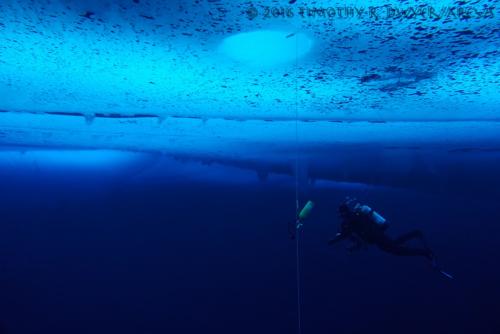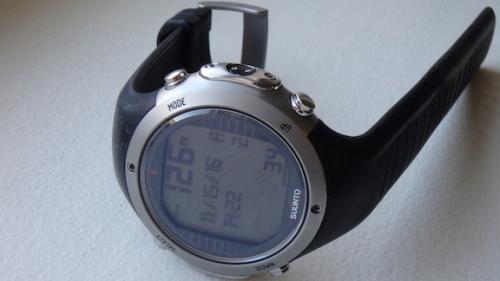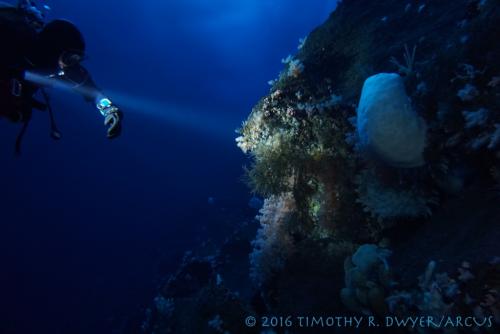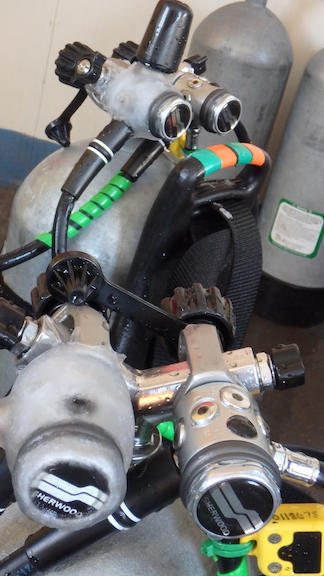 Dr. Bret Tobalske floats near the exit hole at 15ft/5m during his 3 minute "safety stop."
Dr. Bret Tobalske floats near the exit hole at 15ft/5m during his 3 minute "safety stop."
In the 1940s, the Self Contained Underwater Breathing Apparatus (SCUBA) was a revolutionary device in that it released compressed air from a "tank" at an air pressure that a diver's lungs could manage, no matter what the water depth. It did this by automatically compensating for the water pressure the diver (and the SCUBA regulator) were experiencing. Pressure is the force exerted over a given area and it is measured in many different units from pounds per square inch (psi) to kilopascales (kPa) to inches of mercury (inHg) to atmospheres (atm). When we're standing on the sea ice (sea level), one atmosphere is the combined pressure exerted by all the molecules of gas directly above our heads stretching all the way out to the edge of space. I'll use "atmospheres" when talking about pressure because it makes the math a lot easier.
 Wrist-mounted dive computers like this one calculate nitrogen absorption by monitoring depth and duration of the dive.
Wrist-mounted dive computers like this one calculate nitrogen absorption by monitoring depth and duration of the dive.
Gases are highly compressible; a gas under two atmospheres of pressure has the same number of molecules in it as a gas under a single atmosphere but only half the volume. To fill up a diver's lungs under two atmospheres of pressure, then, twice the number of molecules are needed to achieve the same lung volume. At depths of up to 130ft/40m, scientific divers experience pressures up to the weight of five atmospheres of air, compressing the breathing mixture of ~21% oxygen and ~79% nitrogen gas significantly and causing our blood and body tissues to absorb more molecules of both. The pressure exerted by a mixture of gases - such as air - can be broken down into "partial pressures." For air at sea level, the partial pressure of oxygen is 0.21 atm and the partial pressure of nitrogen is 1.0 atm - 0.21 atm = 0.79 atm. Importantly, breathing this gas mixture at 2.0 atm doubles the partial pressures. Breathing it at 4.0 atm quadruples them. The higher the partial pressures of each gas, the more rapidly they are absorbed through our lungs, dissolved into our blood, and eventually delivered to our body tissues.
 Dr. Art Woods uses his light to check his dive computer, careful to stay within acceptable nitrogen limits.
Dr. Art Woods uses his light to check his dive computer, careful to stay within acceptable nitrogen limits.
Diving within our 130ft/40m depth limits, there's no immediate risk by having extra quantities of either molecule dissolved in our bodies unless we surface too quickly. Much the same way that unscrewing the lid on a soda bottle equalizes the partial pressure of the carbon dioxide dissolved inside the soda with the atmosphere outside the bottle, a diver returning to the surface equalizes the partial pressure of nitrogen dissolved inside their tissues. If they have absorbed too much nitrogen, it will come out of the tissues faster than it can be eliminated through normal blood circulation and breathing, creating bubbles inside the diver's body that cause pain and injury. Commonly called "the bends," decompression sickness (DCS) is a real concern and we avoid this malady by planning the depth and duration of our dives and using dive computers to monitor our depth and time underwater. The computers constantly calculate the amount of nitrogen our bodies are absorbing, allowing us keep the nitrogen below a maximum concentration, thereby dramatically reducing the risk of DCS. And just before surfacing, we spend three minutes at 15ft/5m, allowing our bodies a little time to "off gas" at 1.5 atm, further decreasing the risk of DCS. As an even broader degree of safety, rest assured: in the unlikely case that one of us should experience DCS or another pressure-related medical issue, McMurdo Station has the facilities and expertise to resolve it.
 Ice forms on our active SCUBA regulators during every dive, yet not on the adjacent back up regulator. Can you explain why?
Ice forms on our active SCUBA regulators during every dive, yet not on the adjacent back up regulator. Can you explain why?

Comments